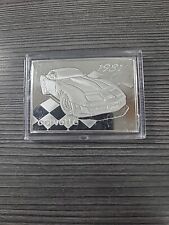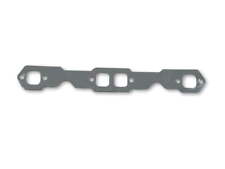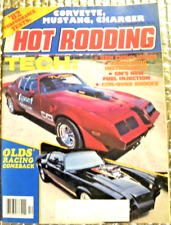1981 Corvette Brochure For Sale

When you click on links to various merchants on this site and make a purchase, this can result in this site earning a commission. Affiliate programs and affiliations include, but are not limited to, the eBay Partner Network.
1981 Corvette Brochure :
$15.59
This is a six-panel brochure for the 1981 ChevroletCorvette. It measures 10 x 10 inches when folded and 10 x 30 when unfolded. Itincludes color photos and illustrations, text, specifications, options, etc.
The 1981 Corvette was a third generation C3 Corvette,spanning years 1968-1982.
The 1981 model year marked a significant milestone in thehistory of the Corvette. While the caritself would primarily be a carryover from the previous model year, it wasannounced that Corvette production would move from the old St. Louis plant to abrand-new, high-tech facility located in Bowling Green, Kentucky.
Although originally developed as an air-conditioning plant,the new manufacturing facility was fully refurbished by General Motors, andwould be dedicated solely to the production of Y-body Chevy Corvettes. It wouldutilize the latest automated manufacturing processes, thereby improving qualitycontrol. The new manufacturing plant would include an up-to-date paint shopthat would utilize more automated paint processing standards, allowingChevrolet to apply more durable enamels to the Corvette, as well as a new clearcoat finishing process.
Interestingly, rumors of a move to a larger, more modernmanufacturing plant began circulating as early as 1973 – especially amongst thecommunities along the Mississippi River that drew their livelihood from GM’sSt. Louis manufacturing plant. Reportedly, the talk was the result of “badblood” between the plant laborers and management. GM vehemently denied therumors that began to propagate.
Additionally, they shot down claims that they were lookingfor a way out of continuing production at the St. Louis plant. Then GM VicePresident Robert F. Magill, in a letter addressed to a Missouri Congressman inthe early 1970’s, stated “We can say categorically that we have no plans forclosing the assembly plant in St. Louis, and any rumors to that effect are withoutfoundation.” Despite these comments,many began to question the continuation of the St. Louis Plant.
The St. Louis Plant was the second General Motors plant tobuild/assemble Corvettes.
First there was the age of the plant itself. Completed in1920, Chevrolet’s St. Louis plant was not only outdated, it was also lacking insize and resource.
In 1953, when GM officials were considering relocation ofCorvette manufacturing from Flint, Michigan to St. Louis, Missouri, the lattermarket seemed to provide an ample supply of skilled tradesmen and laborers tostaff such a large endeavor.
“We selected St. Louis as the exclusive source of Corvettemanufacture because the city has a central location and excellent shippingfacilities, and we have always found here an ample supply of competent labor”said Edward Kelley, Chevrolet Motor Division’s general manufacturing manager.
The Flint, Michigan line ceased operation on December 24,1953. After Christmas, workers on thenew production line in Missouri began assembling their first Corvette just dayslater on December 28, 1953.
The 1981 Chevrolet Corvette was the first model year to bebuilt simultaneously in two locations. The first Corvette assembled at the newBowling Green, Kentucky plant was completed on June 1, 1981. Conversely, thelast Corvette to roll off the St. Louis assembly line did so on August 1, 1981.Also, there was a high number of color choices available for the 1981 Corvette.The reason for the increased number of colors (including some duplicate choices)was that different types of paint were used at each of the two assemblingplants during production.
In 1979, just over a quarter-century later, the rumor millbegan murmuring that the paint facilities in the St. Louis plant were inviolation of the federal air-quality standards established by the EnvironmentalProtection Agency (EPA). Not long after, GM admitted that they were consideringrelocation of their Corvette manufacturing plant to a site that featured aroomier, modernized paint section. On March 26, 1979, GM announced officiallythat an impending move was going to occur.
The announcement of the new Bowling Green Assembly Plantbegan an almost immediate barrage of gossip and rumors that Chevrolet waspreparing for the arrival of an all-new Corvette. For enthusiasts of the car,it clearly indicated that production of the Corvette would continue for theforeseeable future, but that a new model was imminent. After all, why gothrough the trouble of tooling a brand-new plant to continue manufacturing acar that was 13 years old?
It was with a certain amount of irony, therefore, thatproduction of some of the later model 1981 C3 Corvettes would be completed atthe new manufacturing facility. In fact, on June 1, 1981, production of theCorvette began its transition from eastern Missouri to southern Kentucky as thefirst Corvette was completed at the new Bowling Green Corvette plant.
As production at the St. Louis plant drew to a close, mostof its 900 workers eventually relocated to continue working at the new plant.Of the 40,606 Corvettes built for the 1981 model year, 8,995 were manufacturedin Bowling Green, Kentucky.
As for the car itself, the 1981 Corvette fell under theumbrella of the progressively rising CAFE (Corporate Average Fuel Economy) standards. Because of this, Corvette production wasagain evaluated, though in this instance it was to determine what steps couldbe taken to improve the Corvette’s fuel compliance rating as well as help toimprove GM’s compliance as a whole.
It was on this basis that the previous L48 & L82 350cubic inch engines (offered with the 1980 Corvette) were retired in favor of asingle, reworked engine which carried the designation L81. The L81 featuredmagnesium rocker covers and a stainless steel exhaust manifold.
The new, 350 cubic inch V-8 engine was rated at 190 brakehorsepower at 4,000rpm and 280 lbs/ft peak torque at just 1,600rpm. The enginefeatured an auxiliary electric cooling fan that worked in conjunction with asmaller, engine driven cooling fan, which aided in the reduction of noise.
As a result, the 1981 model year was the first sinceCorvette’s earliest days to offer a single engine option for all models –including Corvettes built for sale in California. Making the L81 engine legal for use in Californiawas simply a matter of incorporating the lightweight tube headers (withoxygen-sensor smog controls) and computer controls used by the LG4 V-8 in 1980.
What was even more significant for California consumers wasthat the L81 could be mated to a four-speed manual transmission, meaning thatmanual-trans Corvettes could be sold in that state for the first time since1975. This is also ironic because the1981 Corvette was the last third-generation model to be offered with a manualtransmission. The 1982 Corvette would only be offered with an automatic.
However, the most substantial improvement to the 1981Corvette over earlier models was the introduction of Computer Command Control(CCC). Though not unique only to the1981 Corvette, Computer Command Control used electronics to integrate theemissions and fuel systems in order to reduce smog and fuel consumption.Similarly, CCC was tied into the automatic transmission’s new lockuptorque-converter clutch. This provided a direct mechanical linkage between theflywheel and the propshaft in second and third gears at steady-state speed,thus eliminating gas-eating frictional losses through the converter.
Elsewhere on the car, a few weight savings measures wereintroduced to further help with the improvement of gas mileage. The previouslymentioned magnesium valve covers used on the L81 were actually incorporated asa weight savings measure. Additionally, Chevrolet introduced a mono-leaffiberglass rear spring. Added to automatic-transmission Corvettes with standardsuspensions, this plastic spring weighed only 8 pounds, compared to the44-pound steel leaf springs used in 1980.
Cosmetically, the most notable changes to the car’sphysical appearance occurred to its interior. The dashboard in the 1981Corvette received a more modern and user-friendly makeover, including theintroduction of a standard quartz clock and electronic tuning for all factoryradios. A new six-way power driver’s seat was also introduced (one whichfinally reclined (a notable shortcoming of the seats in earlierthird-generation Corvettes).
Outwardly, the car remained virtually identical as it hadin 1980, with the exception of a new paint option – RPO D84 – that was offeredexclusively for the 1981 Corvette. AsChevrolet officials were extremely proud of their new paint processes at theBowling Green manufacturing plant, they chose to showcase them by featuring atwo-tone paint option on almost all of the cars built that first year. Four two-tone combinations were offered –Beige/Dark Red, Silver/Dark Blue, Silver/Charcoal, and Autumn Red/Dark Claret –with sales of those combinations totaling 5,352.
The price of the 1981 Corvette had again increased from theprevious model year to a base price of $16,258.52. Despite a generally dismal sales year for theentire automotive industry, Corvette continued to do well with 40,606 unitssold that year.
As was stated in a1981 Corvette brochure, “The Bowling Green facility, which will build Corvettesexclusively, is an investment in Corvette’s future. It represents the experience and knowledgelearned over all those years.”
Related Items:
Franklin Mint 1981 Corvette Silver Ingot/Greatest Corvettes Collection .925
$72.79
10808HKR Exhaust Header Gasket Fits select: 1988-1995 CHEVROLET GMT-400
$19.00
Popular Hot Rodding Magazine December 1981 Corvette Mustang Charger 82 Test Pref
$11.75



